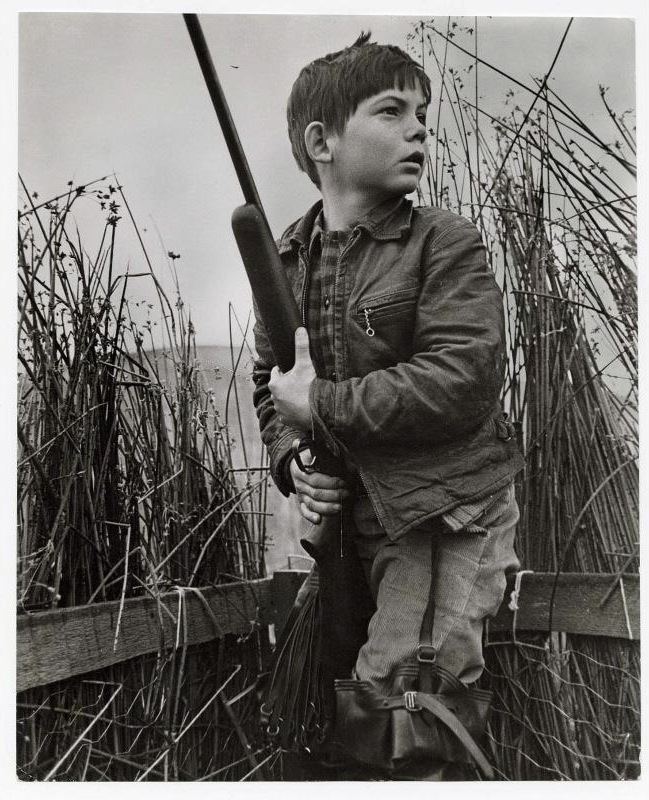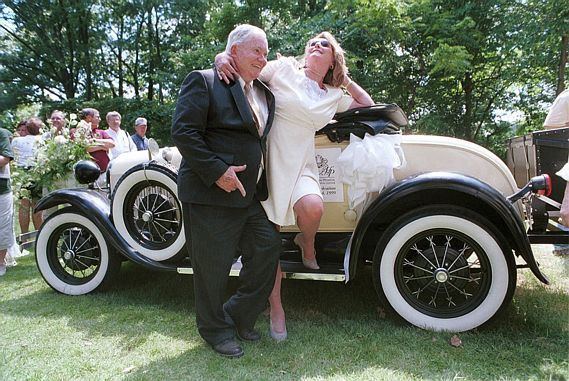Name Gregory Hemingway Occupation Physician, writer | Other names Gloria, Vanessa Nationality American Role Author | |
 | ||
Full Name Gregory Hancock Hemingway Spouse Ida Mae Galliher, Valerie Danby-Smith Similar People | ||
Gregory Hancock Hemingway (November 12, 1931 – October 1, 2001), also known as Gloria Hemingway in later life, was the third and youngest child of author Ernest Hemingway. He became a physician and authored a memoir of life with his father.
Contents

Early life

Born in Kansas City, Missouri, to novelist Ernest Hemingway and his second wife, Pauline Pfeiffer, he was in childhood called Gigi or Gig and was, according to a close observer, "a tremendous athlete" and a "crack shot." As an adult, he preferred the name Greg. Hemingway attended the Canterbury School, a Catholic prep school in Connecticut, graduating in 1949. He dropped out of St. John's College, Annapolis, after one year and worked for a Time as an aircraft mechanic before moving to California in 1951.
Greg married against his father's wishes. Problems with illegal drugs eventually led to his arrest. The incident prompted his father to lash out viciously at his mother, Pauline, in a phone call. Unknown to anyone, Pauline had a rare tumor of the adrenal gland that can cause a deadly surge of adrenaline in times of stress. Within hours of the phone call with Ernest, she had died of shock on a hospital operating table. Ernest blamed his son for Pauline's death, and Greg was deeply disturbed by the accusation. It was years before Greg and Ernest spoke with each other, and Greg never saw his father alive again.
Greg Hemingway retreated to Africa, where he drank alcohol and shot elephants. He spent the next three years in Africa as an apprentice professional hunter but failed to obtain a license because of his drinking. He joined and left the U.S. Army in the 1950s, suffered from mental illness, was institutionalized for a time, and received several dozen treatments with electroconvulsive therapy. Of another period shooting elephants he wrote: "I went back to Africa to do more killing. Somehow it was therapeutic." It wasn't until nearly a decade later, in 1960, that he felt strong enough to resume his medical studies and respond to his father's charges. He wrote his father a bitter letter, detailing the medical facts of his mother's death and blaming Ernest for the tragedy. The next year, Ernest Hemingway killed himself, and again Greg wrestled with guilt over the death of a parent.
He obtained a medical degree from the University of Miami Medical School in 1964.
Relationship with Ernest Hemingway
Father and son were estranged for many years, beginning when Gregory was 19. As an attempt at reconciliation, Hemingway sent his father a telegram in October 1954 to congratulate him on being awarded the Nobel Prize and received $5,000 in return. They had intermittent contact thereafter. He wrote a short account of his father's life and their strained relationship, Papa: A Personal Memoir that became a bestseller. When it appeared in 1976, the preface by Norman Mailer said: "There is nothing slavish here....For once, you can read a book about Hemingway and not have to decide whether you like him or not." The New York Times called it "a small miracle" and "artfully elliptical" in presenting "gloriously romantic adventures" with "a thin cutting edge of malice." Hemingway wrote of his own ambitions in the shadow of his father's fame: "What I really wanted to be was a Hemingway hero." Of his father he wrote: "The man I remembered was kind, gentle, elemental in his vastness, tormented beyond endurance, and although we always called him papa, it was out of love, not fear." He quoted his father as telling him: "You make your own luck, Gig" and "You know what makes a good loser? Practice." Time magazine criticized the author's "churlishness" and called his work "a bitter jumble of unsorted resentments and anguished love." His daughter Lorian responded to Papa with a letter to Time that said, "I would also like to know what type of person the author is...I haven't seen him for eight years...I think it sad that I learn more about him by reading articles and gossip columns than from my own communication with him."
According to his wife Valerie, Hemingway enjoyed his father's portrayal of him as Andrew in Islands in the Stream (1970) and later used the text as the epigraph to his memoir of his father. Valerie included this text as the epigraph to her own tribute to "Gregory H. Hemingway" written two years after his death:
The smallest boy was fair and was built like a pocket battle-ship. He was a Copy of Thomas Hudson, physically, reduced in scale and widened and shortened. His skin freckled when it tanned and he had a humorous face and was born being very old. He was a devil too, and deviled both his older brothers, and he had a dark side to him that nobody except Thomas Hudson could ever understand. Neither of them thought about this except that they recognized it in each other and knew it was bad and the man respected it and understood the boy's having it. They were very close to each other although Thomas Hudson had never been as much with this boy as with the others. This youngest boy, Andrew, was a precocious excellent athlete and he had been marvelous with horses since he had first ridden. The other boys were very proud of him but they did not want any nonsense from him, either. He was a little unbelievable and anyone could well have doubted his feats except that many people had seen him ride and watched him jump and seen his cold, professional modesty. He was a boy born to be quite wicked who was being very good and he carried his wickedness around with him transmuted into a sort of teasing gaiety. But he was a bad boy and the others knew it and he knew it. He was just being good while his badness grew inside him.
Middle years
In the course of his first four marriages, Gregory Hemingway had eight children: Patrick, Edward, Sean, Brendan, Vanessa, Maria, John, and Lorian. One of his marriages, to Valerie Danby-Smith, Ernest Hemingway's secretary, lasted almost 20 years. Gregory's fourth marriage, to Ida Mae Galliher, ended in divorce in 1995 after three years, though they continued to live together and remarried in 1997.
In 1972, Maia Rodman, Hemingway's childhood tennis coach and a family friend who had fallen in love with him, dedicated her book The Life and Death of a Brave Bull to Gregory.
He practiced medicine in the 1970s and 1980s, first in New York and then as a rural family doctor in Montana, first in Fort Benton and later as the medical officer for Garfield County, based in Jordan, Montana. Interviewed there, he said: "When I smell the sagebrush or see the mountains, or a vast clean stream, I love those things. Some of my happiest memories of childhood were associated with the West." In 1988, authorities in Montana declined to renew Hemingway's medical license because of his alcoholism. Hemingway battled bipolar disorder, alcoholism, and drug abuse for many years.
Hemingway and his brothers tried to protect their father's name and their inheritance by taking legal action to stop the popular local celebrations called "Hemingway Days" in Key West, Florida. In 1999, they collaborated in creating a business venture, Hemingway Ltd., to market the family name as "an up-scale lifestyle accessory brand". Their first venture created controversy by putting the Hemingway name on a line of shotguns.
Gender identity
For years, Hemingway claimed, he had experienced gender dysphoria. He experimented with wearing women's clothes on a number of occasions. Wife Valerie wrote:
All his life Greg fought a losing battle against this crippling illness. He lacked critical early help because his parents were unable or unwilling to accept his condition nor could he come to terms with it himself for a long time, taking up the study of medicine in the hope that he would find a cure, or at least a solace. Failing that, he developed an alternate persona, a character into which he could retreat from the unbearable responsibilities of being, among other things, his father's son, and of never ever measuring up to what was expected of him, or to what he expected of himself.
Hemingway considered gender reassignment surgery as early as 1973. He had the surgery in 1995 and began using the name Gloria on occasion. Despite the surgery, Hemingway, presenting as a man, remarried Galliher in 1997 in Washington state.
Hemingway's public persona remained male. As Gregory, he gave interviews about his father as late as 1999. In July of that year he attended events marking the centenary of Ernest Hemingway's birth in Oak Park, Illinois. He also spoke at the dedication of the Hemingway-Pfeiffer Museum in his mother's family home in Piggott, Arkansas, when it opened on July 4, 1999.
Hemingway's transition from male to female was a long process left incomplete at his death. He had breast implant surgery on one breast and then had it reversed. He was sometimes seen in women's attire, yet, dressed as a man, he frequented a local tavern and presented as what a patron called "just one of the guys." When he was arrested just days before his death, he first gave the police the name Greg Hemingway, then changed it to Gloria.
Death
Hemingway died October 1, 2001, of hypertension and cardiovascular disease in Miami-Dade Women's Detention Center. That day, Hemingway was due in court to answer charges of indecent exposure and resisting arrest without violence. Hemingway had been living in Florida for more than ten years.
In most obituaries, he was called Gregory, but Time magazine published a brief notice of the death of "Gloria Hemingway, 69, transsexual youngest son turned daughter of novelist Ernest Hemingway" and noted the novelist once said Gregory had "the biggest dark side in the family except me." The gravestone reads: "Dr. Gregory Hancock Hemingway 1931–2001". He is buried next to his father and half-brother Jack in the Ketchum, Idaho cemetery.
Hemingway left two wills. One will left most of the $7,000,000 estate to Galliher. The other left most of it to Hemingway's children. The children challenged the will that named Galliher as heir, claiming that Galliher was not legally Hemingway's widow since Hemingway's home state of Florida did not recognize same-sex marriages. The parties eventually reached an undisclosed settlement.
Children
Daughter Lorian Hemingway wrote about her father in the 1999 book Walk on Water: A Memoir. Son Edward, an artist, has written and illustrated the children's books Bump in the Night, and "Bad Apple". Son John wrote the critically acclaimed memoir Strange Tribe: A Family Memoir. Son Patrick is a professional photographer based in Vancouver, British Columbia, Canada. Son Seán is the curator of Greek and Roman Art at the Metropolitan Museum of Art in New York City.
